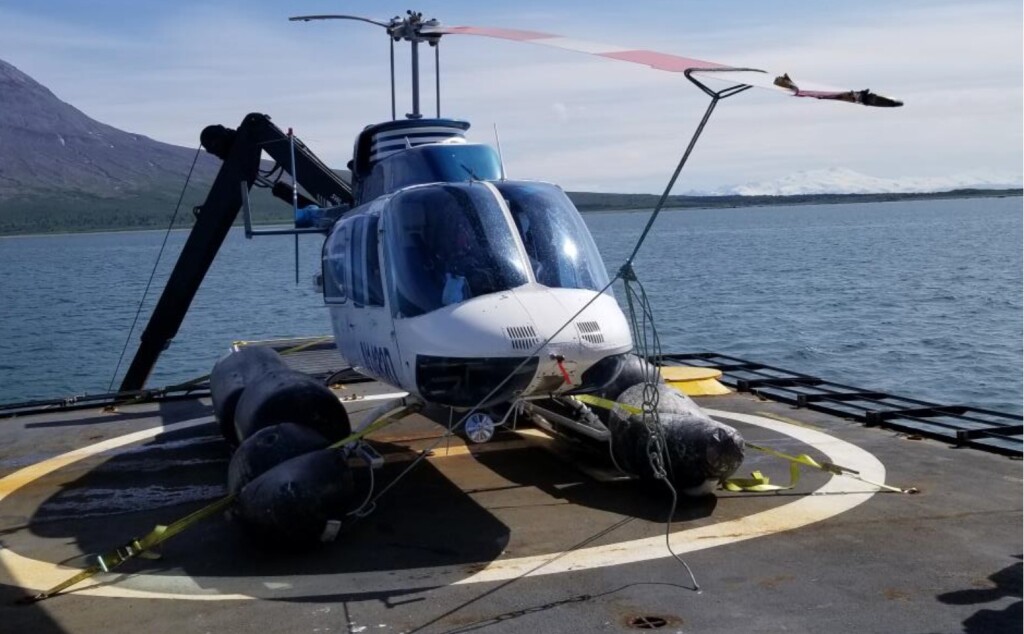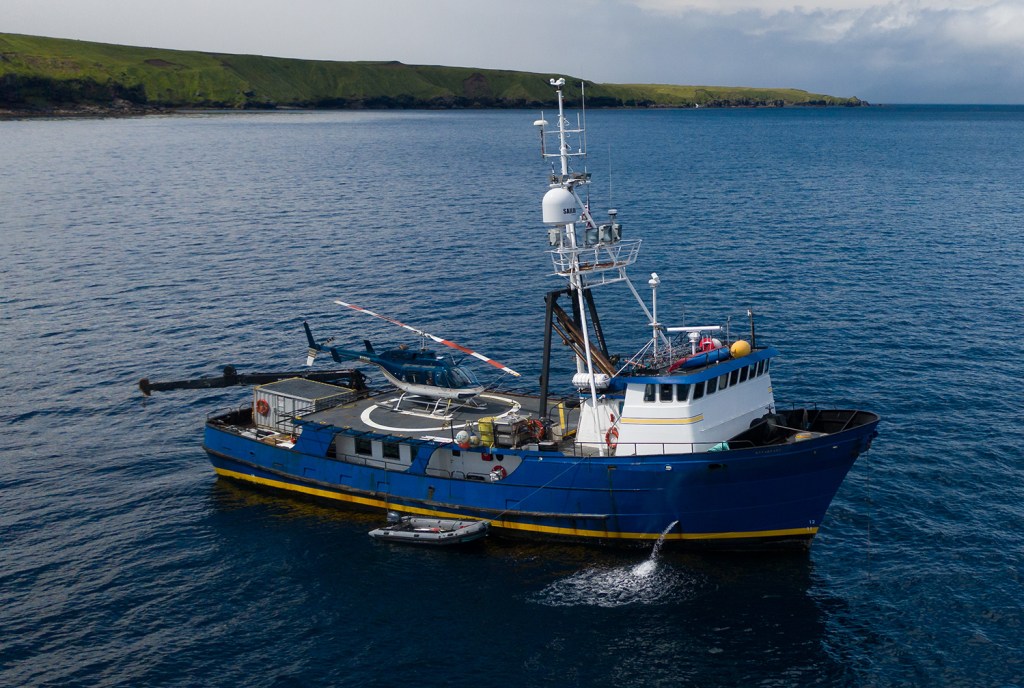Ditching after Blade Strike During HESLO from a Ship (B206-L1 N1422D Alaska)
On 16 July 2020 Bell 206L-1 N1432D (MSN 45741) of Egli Air Haul was damaged in a collision with the mast of the Research Vessel Steadfast and then ditched while conducting a Helicopter External Sling Load Operation (HESLO).

Bell206L-1 N1432 Recovered Aboard RV Steadfast Following a Main Rotor Blade Strike During HESLO and Ditcing (Credit: Operator via NTSB)
The Circumstances of the Accident
The accident occurred near Augustine Island, Cook Inlet, Alaska, according to the US National Transportation Safety Board (NTSB) safety investigation report published on 20 August 2021. While the NTSB summary is disappointingly brief, the pilot’s account gives excellent detail and context. The 68-year-old pilot, who had a vast 26,995 hours of flying experience (26,769 in command, 14185 in rotorcraft in total, 14060 in command of rotorcraft and 521 on type), described that after arrival onboard the vessel the day before:
I conducted a thorough helicopter safety briefing with all the personnel on board the boat. We discussed tail rotor and main rotor precautions and safety, location and operation of emergency equipment, seat belt and door operation and use. We discussed procedures for securing the helicopter to the deck using ratchet straps. We also briefed regarding sling load procedures and safety.
The 33 m Steadfast is a converted 1973 Bering Sea crab fishing vessel.
The helideck surface is approximately 13 m by 8.5 m. The D-value of a B206L-1 is 12.9 m so this is a sub-1D deck.
During the sling load safety briefing, the Boat Engineer asked me how long my helicopter longline was. I told him “50 feet”. He asked me if it was long enough. I asked him how tall the boat mast was. He said he did not know. Nobody else on the boat knew how high it was, either. I looked up at the top of the mast from where I was standing on the helideck, judged that it was less than 50 feet, and said to the group that I thought the 50-foot line would be long enough. We completed the sling load safety briefing, covered aircraft refuelling procedures, and began preparing for the work that lay ahead for all of us. Then after dinner, I flew a couple of personnel loads (all internal loads only) and we did some work on Augustine Island and Mount St. Augustine Volcano. We ended our day without incident.
On the next day:
I flew one work crew off the boat out to a volcano seismic monitoring site [AC59]…[then]…took off with the longline attached to the helicopter belly hook and flew to the boat. As the boat crew was accomplishing the hovering hookup, I was observing the highest point of the boat mast was below the helicopter, so I felt that the longline would in fact be long enough. I flew the first load off the helideck to AC59, where the ground crew unhooked the load. Then I flew a second crew from the boat to Lagoon Camp (LGCP) on Augustine Island where they would spend the day receiving and handling construction materials I would be sling loading off the boat to them throughout the day. l anticipated it would require around 20 sling loads to move all the lumber and materials coming off the boat. At LGCP I shut down the helicopter.
The pilot familiarised himself with the work site, set up a drum-stock refuelling station and had lunch.
At around 13:30 I commenced sling load operations to LGCP. I hooked up the longline to the helicopter belly hook on the ground at LGCP and flew the empty longline hook out to the boat for a load. I flew the empty longline back to the boat for another load, where the boat crew hooked me up to it and I flew it to LGCP for the ground crew to unhook. I repeated this for a total of 8 sling loads, including a backhaul 3 times with empty cargo nets attached to the cargo hook back to the boat.
The helicopter was now close to reserve fuel. The Steadfast radioed that one load was ready, but the next would need time to be rigged and ready. The pilot decided to refuel ashore, landing at 14:36. He departed at 14:57, lifted two more loads ashore. When returning to the vessel with two empty underslung cargo nets the vessel again radioed there would be a delay for the next load. The pilot landed on a beach to await the vessel, getting airborne again at 15:13
On my arrival over the helideck, as I was working to set the empty cargo nets on deck, the helicopter suddenly began shaking violently I immediately realized I must have had a rotor strike with the boat. I punched off the longline and pulled the float inflation trigger to inflate the floats. I flew the helicopter under power into the wind forward a safe distance away from the boat As the float inflation sequence finished, well clear of the boat: with the aircraft shaking more violently than before, I landed the helicopter under power and full control in the water, splashing down at 15:15. As I rolled the throttle to idle, I heard someone on the radio talking about what to do, or whether to transmit MAYDAY I responded that I was completely OK, and to just get me out of the water Then I shut off the electrical systems and radios and completed an immediate shutdown.
The uninjured pilot was able to board a zodiac boat direct from the helicopter’s emergency floats at 15:16. Post-accident examination revealed that both main rotor blades had struck the mast. The helicopter was deregistered 28 June 2021 and exported to Queensland, Australia and re-registered VH-NUF with Coral Coastal Helicopters.
The Pilot’s Safety Recommendations
The pilot suggested three sensible safety recommendations (only one of which the NTSB) include in their brief report:
First of all, I should have insisted on an actual tape measurement of the boat mast height, instead of estimating it from standing on the boat deck. Secondly, with a 100-foot long-line, I would have been able to reach the cargo hook to the boat deck with all points of the boat in my vertical reference view hovering over the load, with no part of the boat in my “blind spot” I needed more margin for load control and maneuvering than was possible with the 50-foot long-line I was using at the time. Thirdly, it would have been valuable input for the boat crew to have noticed how closely I was actually hovering to the top of the boat mast during the prior loads I had slung on and off the boat already, and to have said something to me about it. I do not say this to try and shift any blame their way. I should have asked for this during our safety briefing, or during sling operations.
The last point is a mature and reflective observation about safety collaboration, teamwork and engagement.
The NTSB Probable Cause
The Board determined a rather simplistic probable cause and contributory factor:
The pilot’s failure to see and avoid the boat’s mast, which resulted in a main rotor blade strike. Contributing to the accident was the pilot’s inadequate preflight planning by not having the boat’s mast measured.
Safety Resources
The European Safety Promotion Network Rotorcraft (ESPN-R) has a helicopter safety discussion group on LinkedIn. You may also find these Aerossurance articles of interest:
- HESLO Dynamic Rollover in Alaska
- Sécurité Civile EC145 Mountain Rescue Main Rotor Blade Strike Leads to Tail Strike
- Sécurité Civile EC145 Mountain Rescue Blade Strike
- Sécurité Civile EC145 SAR Wirestrike
- Windscreen Rain Refraction: Mountain Mine Site HESLO CFIT
- When Habits Kill – Canadian MD500 Accident
- Loss of Control During HESLO Construction Task: BEA Highlight Wellbeing / Personal Readiness
- Shocking Accident: Two Workers Electrocuted During HESLO
- Load Lost Due to Misrigged Under Slung Load Control Cable
- Keep Your Eyes on the Hook! Underslung External Load Safety
- EC120 Underslung Load Accident 26 September 2013 – Report
- Unexpected Load: AS350B3 USL / External Cargo Accident in Norway
- Unexpected Load: B407 USL / External Cargo Accident in PNG
- Load Lost Due to Misrigged Under Slung Load Control Cable
- Fallacy of ‘Training Out’ Error: Japanese AS332L1 Dropped Load
- Helicopter External Sling Load Operation Occurrences in New Zealand
- Maintenance Issues in Fire-Fighting S-61A Accident
- Impromptu Landing – Unseen Cable
- Inadvertent Entry into IMC During Mountaintop HESLO
- HESLO AS350B2 Dropped Load – Phase Out of Spring-Loaded Keepers for Keeperless Hooks
- Unballasted Sling Stings Speedy Squirrel (HESLO in France)
- UPDATE 4 September 2021: Dynamic Rollover During HESLO at Gusty Mountain Site
- UPDATE 25 September 2021: Fuel Starvation During Powerline HESLO
- UPDATE 16 October 2021: South Korean Fire-Fighting Helicopter Tail Rotor Strike on Fuel Bowser
- UPDATE 30 October 2021: RLC B407 Reverses into Sister Ship at GOM Heliport
- UPDATE 7 November 2021: Italian Alps AW139 Mountain Rescue Hoisting Blade Strike
- UPDATE 1 January 2022: Snagged Sling Line Pulled into Main Rotor During HESLO Shutdown
- UPDATE 3 September 2022: Garbage Pilot Becomes Electric Hooker
- UPDATE 18 March 2023: HESLO AS350 Fatal Accident Positioning with an Unloaded Long Line
- UPDATE 5 August 2023: A Concrete Case of Commercial Pressure: Fatal Swiss HESLO Accident


Recent Comments